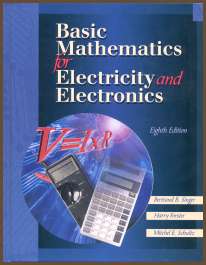
Basic Mathematics for Electricity and Electronics 8/e
by Bertrand B. Singer, Harry Forster, Mitchel E. Schultz
Glencoe/McGraw-Hill, 2000
897 pages, hardcover
ISBN 0-02-805022-3
$113.33 list, Click to purchase at Amazon.com
Book reviewed 2004.08.13
This is the book for you if you are struggling to understand how to apply the basic laws of electronics: Ohm's, Thevenin's, Norton's, Kirchhoff's, etc. This book starts from basic arithmetic, works slowly up through fractions, and only winds up at school algebra about halfway through the book. By the end of the book they've touched on vectors, trigonometry, AC power, and Boolean algebra. These more advanced subjects are all treated at a very basic level: there is no advanced algebra, the trig is no more than is necessary to understand vectors, the vector math is only there to make phasor diagrams useful, phasors are only covered to make 3-phase power understandable, etc.
The book's has a tilt towards the world of the industrial electrician, rather than that of the electronics technician. A symptom of this is that inductance is covered before capacitance — motors are more visible than capacitors — the opposite of the usual way in teaching electronics.
This book will not teach you electronics, per se. You need to be reading this book along with an electronics text.
This is a text book, not a narrative. It's all here as you remember from your grade school math books: word problems, partial lists of answers in the back of the book, worked example problems, etc.
The Bottom Line
If you got through trig in high school or you've already read The Art of Electronics and didn't find the first chapter particularly hard going, this book is way too elementary for you.
This book is best for those who never made it past basic algebra in school. In fact, I think it would make an excellent adjunct to a secondary school math course for those with an interest in electronics. So often, the math problems in school books don't teach as well as they might because it's hard to see the application to interesting problems. This book might bridge that "interest gap" for a student and so smooth their uptake of the class textbook's material.
If you're on the fence about this book, observe that it's in its eighth edition, and that it's been evolving for nearly 50 years! The authors must be doing something right to keep the book going that long.
Related Resources
McGraw-Hill has a page dedicated to this book.
You can get more reader reviews at the Amazon.com link above.